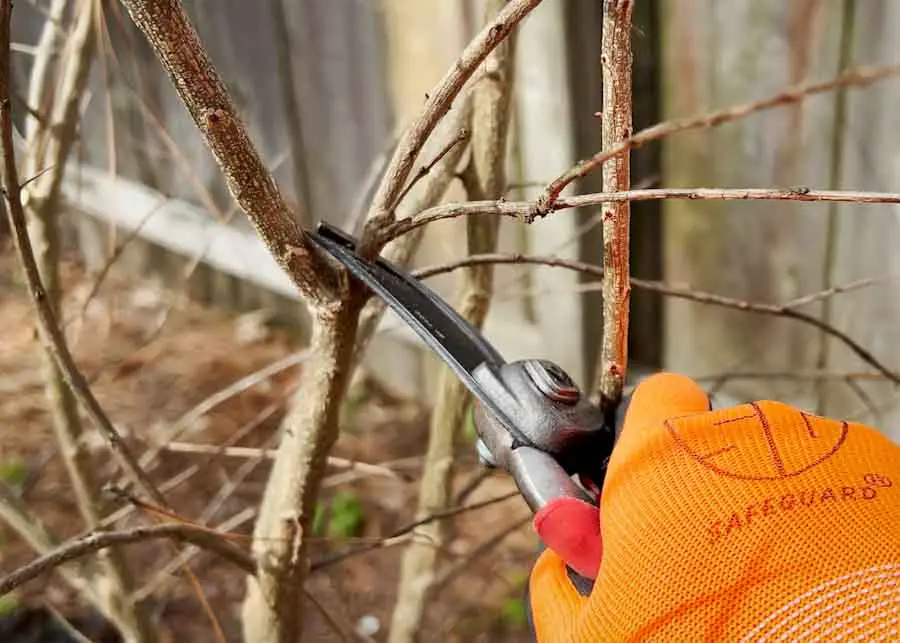
We may receive commissions from purchases made through links in this post, at no additional cost to you.
Pomegranate trees are one of the simplest fruit trees to grow, even for novice gardeners. They are suited to a wide variety of climates
Pomegranate trees should be pruned primarily in the late winter or early spring, once the danger of frost has passed. Trim root suckers and damaged growth any time during the growing season. Prune to increase airflow, light exposure, control excessive growth, and improve fruit quality.
Pruning a pomegranate tree is fairly simple…arguably easier than attempting to eat one of the fruits. For me, tackling a task like pruning starts with understanding what exactly I’m trying to accomplish. Continue reading to find out why pruning pomegranate trees is necessary, what times of year are best for pruning, and how to go about doing it.
Pomegranate Pruning: The Objectives
Like many fruit trees, pomegranate trees need yearly pruning to grow and fruit their best. Before making the first cut, take a moment to consider what you are trying to accomplish:
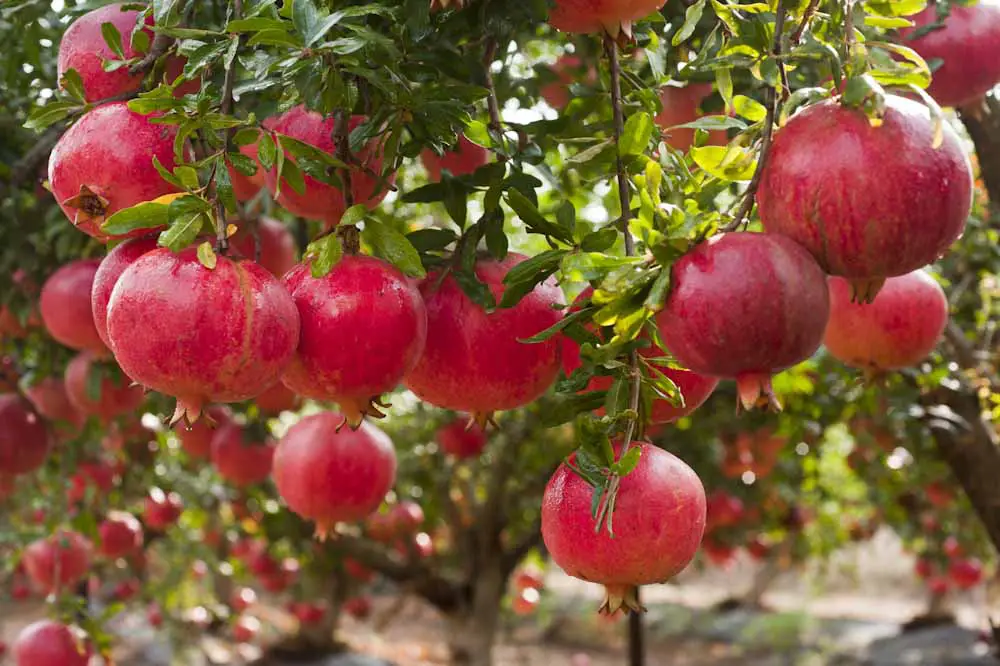
Bigger, Better, and More Fruit
Pruning removes excessive shoots from the tree and directs energy toward the remaining growth. It may seem counterintuitive, but strategically removing branches (to a point) will help the tree grow more fruit.
The nutrients and water taken up by the roots will go to supporting fruit development, rather than tons of leaves and new shoots. This means the pomegranates will grow larger, more prolifically, and have better flavor.
Sunlight Penetration
Pomegranates love heat and sunlight. Pruning opens up the center of the tree and eliminates branches growing too close together, allowing light to reach all parts of the tree. The better the light penetration, the better the size, color, and flavor of the pomegranates. After all, it’s photosynthesis that converts light to sugars, which are then stored in the fruits.
Learn more: Simple Tips to Grow Sweeter Pomegranates

Curious about any garden-related terms? Click on a highlighted word in the text, or visit The Fruit Grove Glossary to find out more.
Shaping
Even if the fruit weren’t delicious, pomegranates would be worth growing because of their ornamental qualities. But if left to its own devices, a pomegranate shrub can grow a bit wild-looking. Pruning helps maintain the form and size of a pomegranate bush or tree, allowing it to fit in just about any landscape.
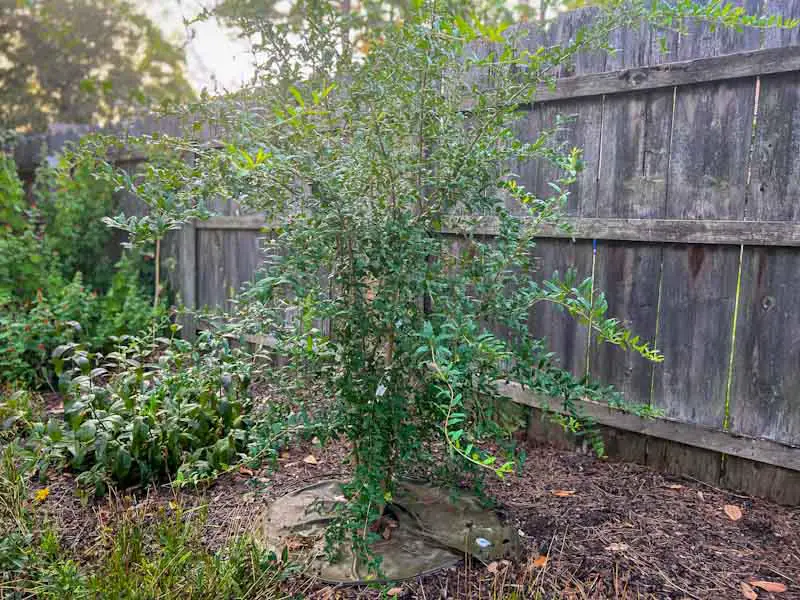
Pomegranate trees can be pruned as a multi-stemmed shrub or a single-trunk tree. Left unpruned, they will grow to 15 feet or more, but pruning can keep them to a polite 8-12 feet. Some dwarf varieties can stay tiny (under 3 feet), or just about any pomegranate tree can be grown happily in a pot with simple trimming.
Learn more: How Big Will a Pomegranate Tree Grow?
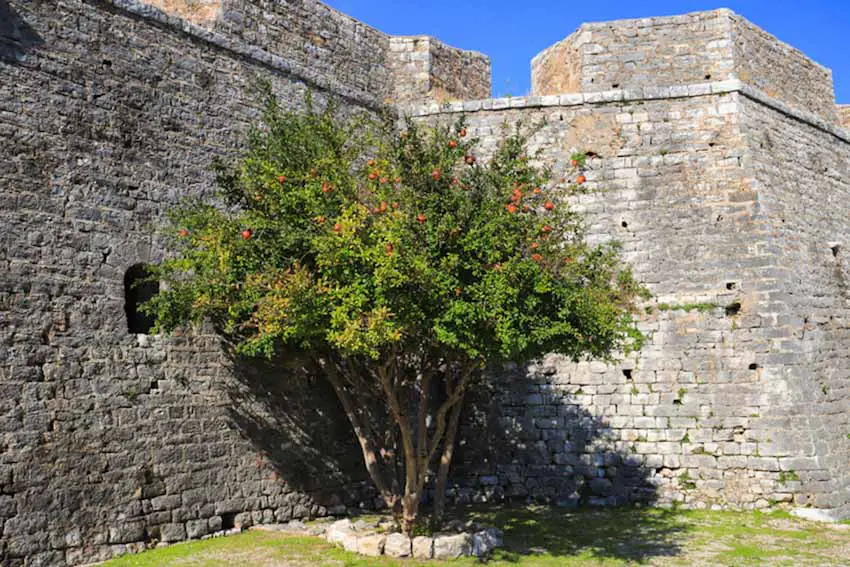
Rejuvenation of Fruiting Wood
Those pesky shoots at the base of a pomegranate bush serve an important purpose. Pomegranate trees grow new fruiting wood at the ends of the current year’s growth, but those fruiting spurs will continue bearing pomegranates for several years.
When the quality of a particular branch’s fruit starts to diminish, trim it down to the ground and allow a new shoot to grow up and replace it. This strategy allows for a continual renewing of the pomegranate tree’s fruiting wood.
Related: Perfect Timing: When Does a Pomegranate Tree Bloom and Fruit?
Ease of Harvesting
This is a simple but practical reason to prune: Since most pomegranates grow at the ends of branches, if those branches are extremely tall, the fruit will be hard to get to. Pruning keeps the pomegranates within an easy arm’s reach.
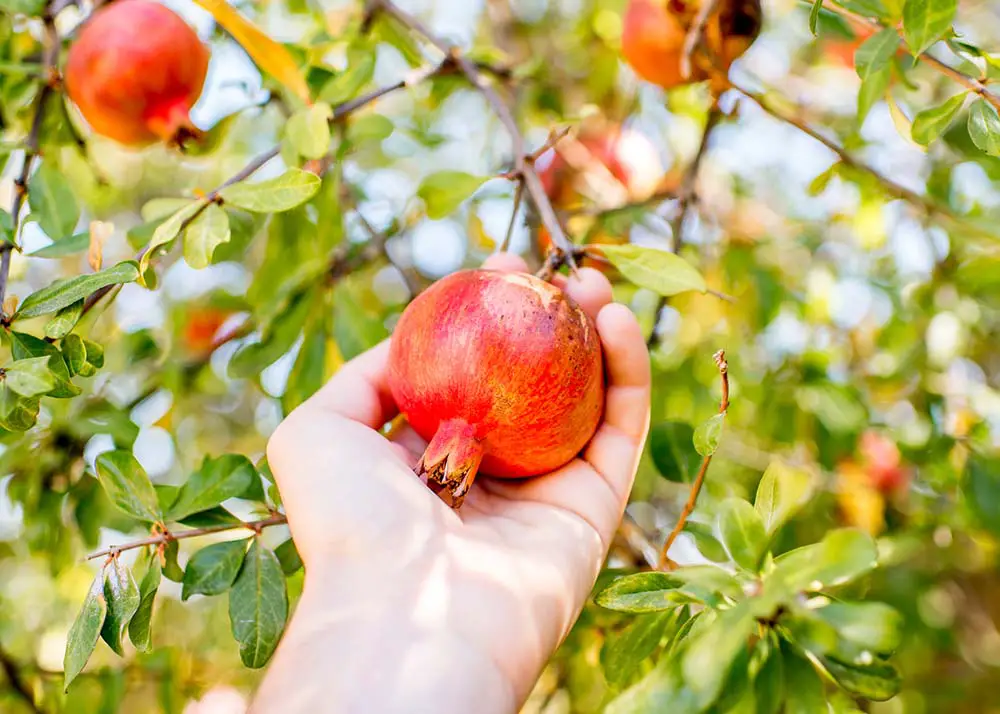
Thinning out the center of the tree also makes it easier to harvest fruit. Pomegranate trees can have pretty aggressive thorns, so it helps to have room to reach between the branches.
Related: Picking Perfect Pomegranates: How to Know It’s Harvest Time
When to Prune a Pomegranate Tree
In general, pomegranate trees should be pruned in late winter or early spring before new growth emerges. Some light pruning can also be done in autumn after the fruit harvest. Remove root suckers whenever they appear, at least once per season.
Pomegranate trees are deciduous, so they lose their leaves and become dormant in the winter. Deciduous trees are typically pruned at the end of winter before they wake up from dormancy. Pruning at this time can actually trigger the tree to start growing again, so it’s important not to prune too early in the winter. The tender new growth is highly susceptible to frost damage.
In the northern hemisphere, the time to prune pomegranate trees will fall somewhere between January and March (July and September in the southern hemisphere). The ideal window of time is after the area’s average last frost date (find yours here) but before bud break.
Learn more: Watch the video below to see the process of pruning my ‘Wonderful’ pomegranate tree.
Pomegranate trees tend to send up new shoots from the base of the plant throughout the growing season. If allowed to grow, these root suckers will crowd the tree and take its energy away from fruit development. Cut suckers down to the ground whenever you notice them, at any time during the growing season.
Pruning Tools
Below are the tools you need to prune a pomegranate tree (or any fruit tree). Pruning is infinitely easier if you have the right tools – but it’s also essential that the tools are sharp, clean, and sanitized.
Learn more here: Simple Ways to Clean and Maintain Your Pruning Tools
- Bypass pruning shears – Handheld pruning shears are used for branches and twigs smaller than about 3/4 of an inch. I recommend this Felco F-2 Hand Pruner for its durability, even though it’s a little pricier. It has a lifetime guarantee, and all of the parts are replaceable. A good budget option is these Gonicc Bypass Pruning Shears. They may not last as long, but they will do the job well.
- Loppers – Loppers are used to cut through branches that are up to 2 inches thick (depending on the size of the loppers and how they are constructed). I like these 30-inch loppers by Tabor Tools.
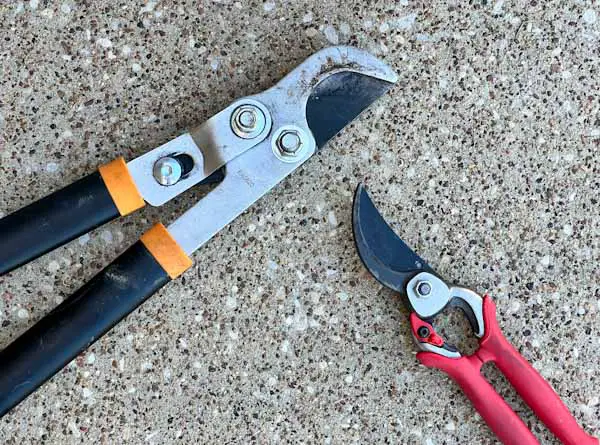
- Pruning saw – If your pomegranate tree is more mature, you may need a pruning saw like this one to cut through the thickest branches. Pruning saws are different from carpentry saws in that they only cut on the pulling stroke (rather than both pulling and pushing). This makes for cleaner cuts that heal more quickly. A ragged pruning wound will leave the tree susceptible to rot or pests.
- Rubbing alcohol (isopropyl alcohol) – Use 70% isopropyl alcohol to sanitize cutting tools between cuts (or at least between trees). Simply saturate a clean rag with the alcohol and wipe down the tools, focusing on the cutting surfaces. Or, use a spray bottle to spray the alcohol, then wipe clean.
- Heavy duty gloves – Pomegranate trees have large thorns, so heavy-duty gloves are essential for protecting your hands from scratches. Look for ones that are thorn-proof but easy to maneuver in. I like this pair because you can use it with a touch screen (useful for listening to podcasts while gardening).
- Long sleeves – Again, long sleeves (and long pants) are a good idea to protect your arms from thorns.
- Stepladder (optional) – Depending on the height of your tree, a stepladder or step stool will help you safely reach the top branches.
How to Prune a Pomegranate Bush or Multi-Stemmed Tree
Most pomegranate trees are grown as multi-stemmed trees, meaning a few main shoots are selected as the structural trunks of the tree, then branches grow off of each trunk. This is the form that allows for the best fruit production.
You can also grow a pomegranate shrub by allowing even more shoots to grow from the base, and then trimming the shrub yearly to keep a nice form. If your goal is to make the plant more ornamental, then this is a good option. But if fruit is your main goal, a multi-stemmed form is best.
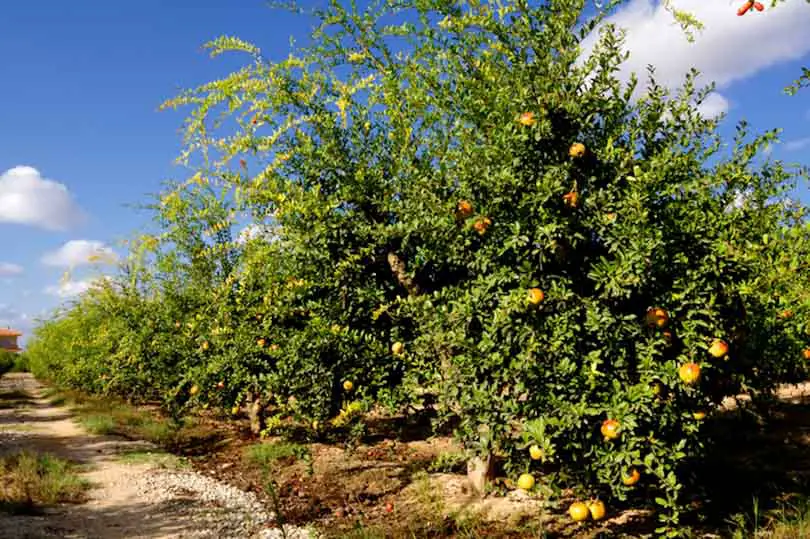
It’s important to restate that the amount of pruning needed will vary widely depending on the climate, tree age, and the pomegranate cultivar.
Pomegranate trees grow much more vigorously in hot climates, so those in cooler zones may not have to do as much. Some cultivars grow aggressively while others naturally stay more compact. And younger trees have different pruning needs than mature ones (see the pruning steps below).
Wherever you live, or whether you choose to grow a pomegranate bush or a multi-trunk tree, the process of pruning is very similar.
Pruning a Young Pomegranate Tree
When you buy a pomegranate tree from a reputable nursery, it will probably come pre-pruned to an appropriate height. If not, then cut the tree so each shoot is 2-3 feet long at planting time.
Once the tree is planted, do not prune it at all during the first growing season (other than the initial shortening cut, if needed). Wait until the tree is dormant to prune.
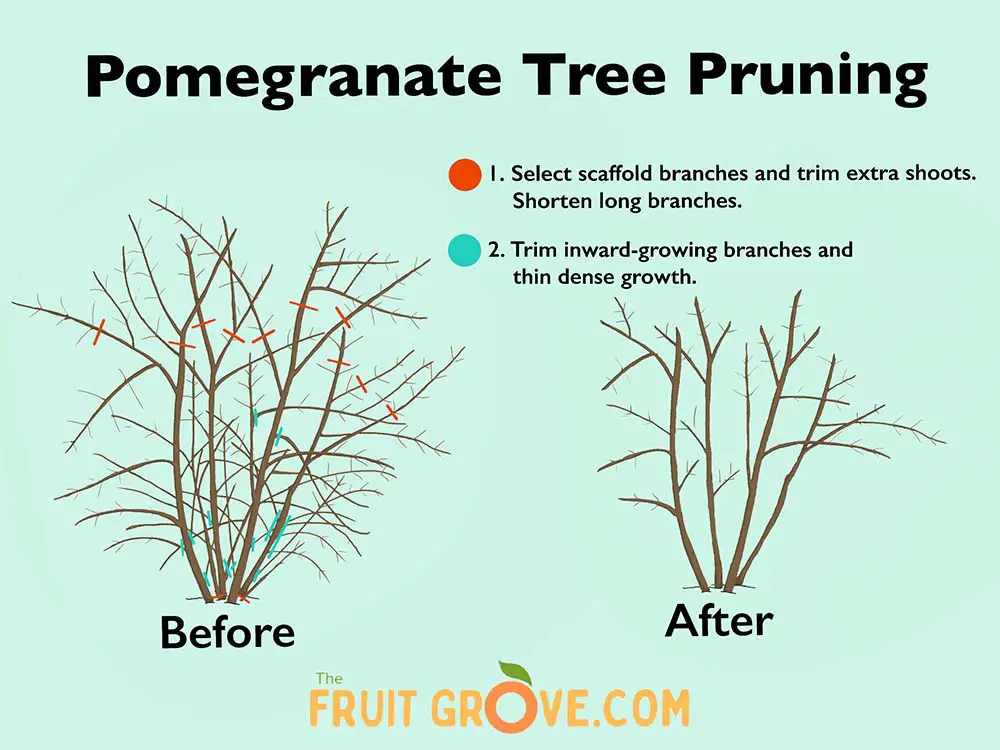
Step 1:
In the first dormant season (late winter), select 3 to 6 main scaffold branches. Choose shoots that look strong and healthy and are evenly spaced around the tree. Ideally, keep the center of the plant open so sunlight and air can circulate. Use a thinning cut to remove the other shoots to ground level. If you haven’t already, shorten each of the scaffold branches to 2-3 feet high.
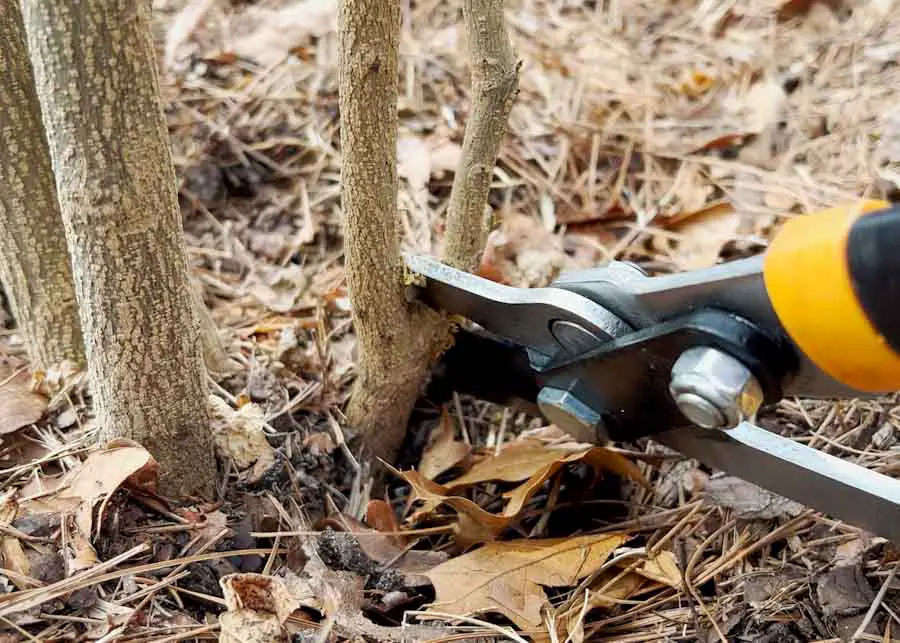
Step 2:
Trim inward-growing branches and thin out areas where branches are too close together. The idea is to allow light and air to flow throughout the plant. Also trim branches that are growing too close to the base (to avoid heavy fruit sitting on the ground).
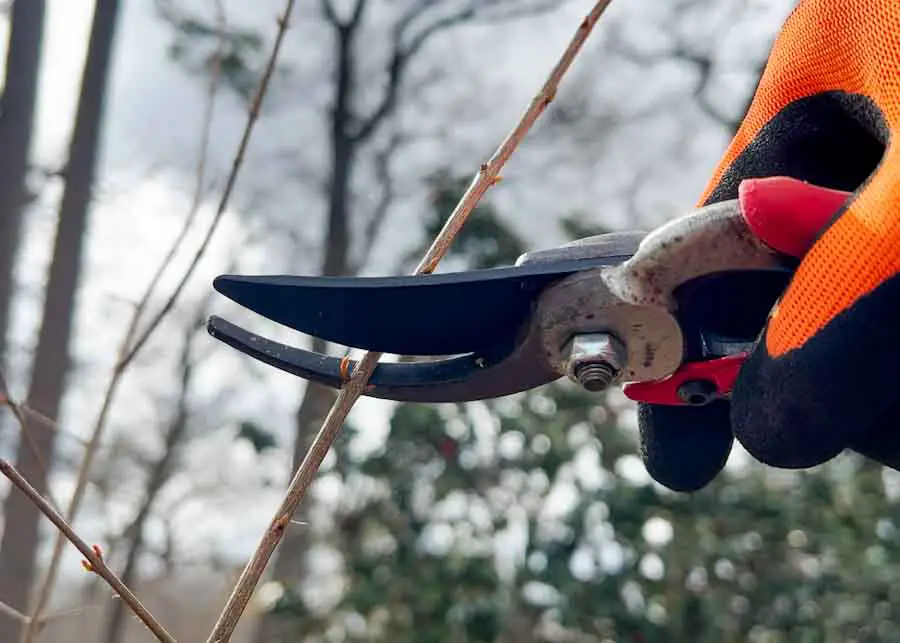
Step 3:
The following seasons, prune in the late winter/early spring after the last frost date, but before new spring growth begins. Remove root suckers from the base of the plant. Tip-prune (using a heading cut) the scaffold branches by about 1/3 to shorten them and encourage them to grow thicker. Remove any dead, diseased, or crossing branches.
Step 4:
Always remove root suckers whenever they appear during the growing season. These shoots grow up vigorously and will take energy away from the establishing root system and main branches.
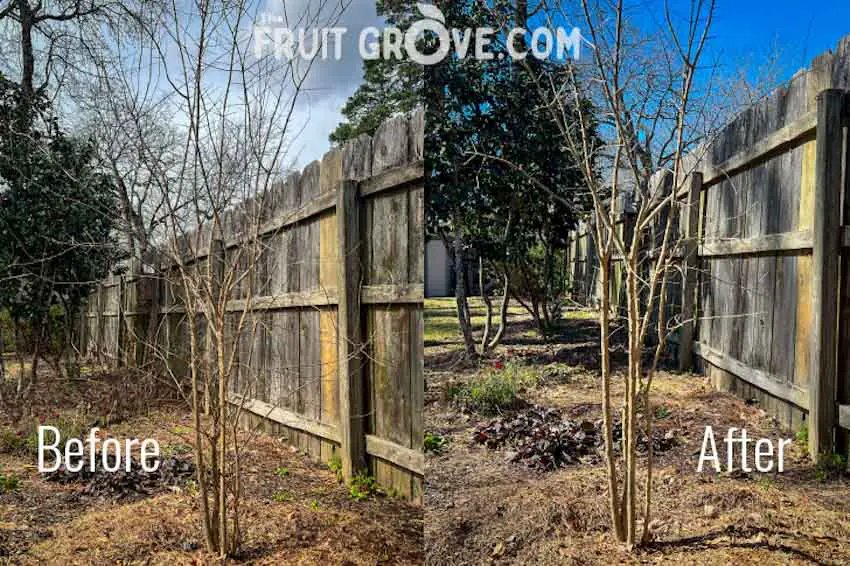
Pruning an Established Pomegranate Tree (After Year 3)
- After a tree’s third season, prune lightly each winter to encourage fruit production and control size.
- Remove root suckers, dead or damaged growth, and crossing or inward-growing branches.
- Tip-prune long branches by about 1/3.
- After a year of little growth, you can prune a bit more heavily to reinvigorate the plant.
- After a few years, when you notice fruit production slowing, allow 1 or 2 new shoots to grow from the base. Cut 1 or 2 old, woody scaffold branches down to the ground and allow the new shoots to replace them. Stagger which scaffolds you replace so that you always have a mix of old and new fruit-bearing scaffolds.
- In the fall after harvest, remove dead, damaged, or diseased growth and any old or diseased fruits to keep pests from overwintering on the tree. If some branches have grown extremely long, go ahead and trim the length just a little (less than a foot). Too much trimming this time of year will interfere with the following season’s fruit production. Rake away fallen leaves and other debris to discourage overwintering pests.
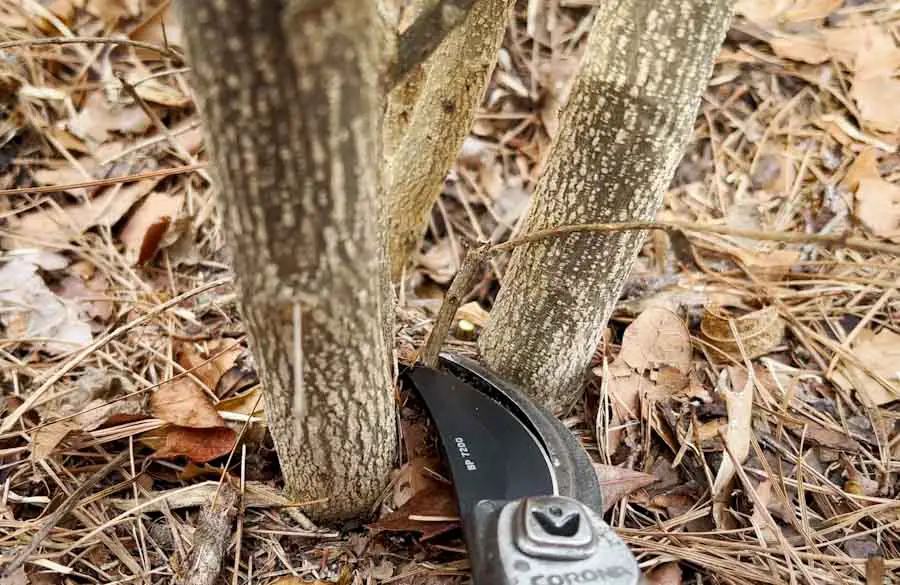
How to Prune a Single-Stemmed Pomegranate Tree
The third shaping option is to grow a pomegranate plant as a single-trunk tree. It will take a lot of work to establish this form since it goes against the natural shrubby tendencies of the plant. But there are some advantages to shaping the tree this way.
For one thing, a single-trunk tree can more easily fit into a narrow space. Pomegranate shrubs can grow pretty wide and wild if not kept in check. Once a tree is established on its one trunk, it will stay a bit more contained in the garden.
Growing pomegranates on a central leader tree also keeps the fruit from dragging on the ground. The heavy fruits tend to weigh down branches, especially since they usually grow on branch ends. A tree form will keep the pomegranates off the ground and away from ants and other pests.
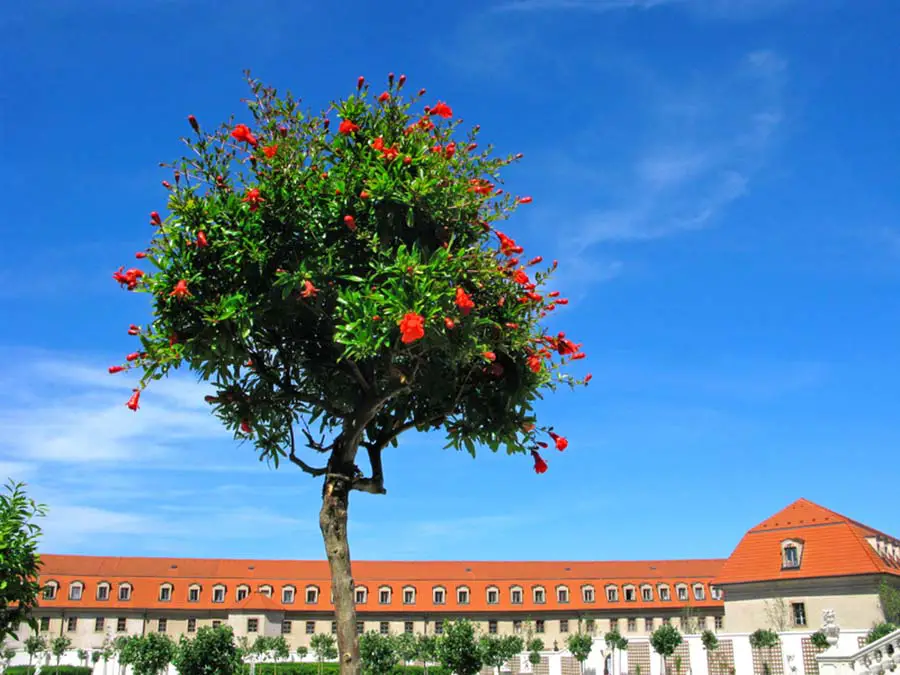
A couple of notes of caution, however: Single-stem pomegranate trees can potentially grow even taller than their shrubby counterparts, which can complicate things like pruning and harvesting fruit. It’s possible to keep a tree shorter, especially if you start with a dwarf variety, but it will take more aggressive pruning.
If you live on the colder side of a pomegranate’s growing range (USDA zone 7 or lower), a single-trunk tree could be more susceptible to cold damage. If one shoot dies back on a multi-stem tree, it’s simple to allow another to grow and replace it. If the only trunk dies, however, you have to start from scratch.
It will take more work in the first few years to keep aggressive new shoots and suckers in check, but a single-trunk pomegranate tree may take less maintenance in the long run once it’s established. Here are the steps to prune and shape a single-stem pomegranate tree:
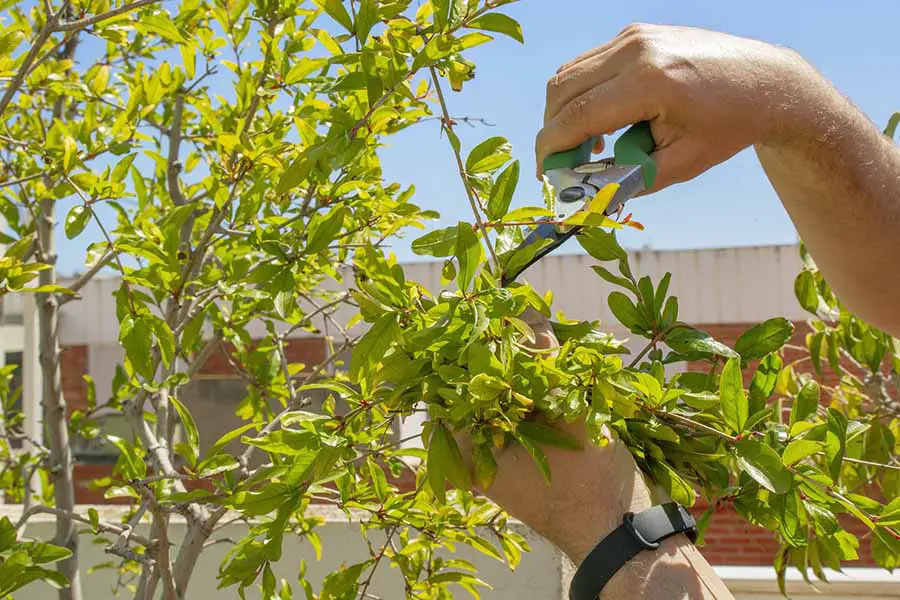
- At planting, choose a strong central vertical shoot to train into the trunk. Cut all other shoots to ground level. Shorten the main single shoot to 18-30 inches high.
- Cut root suckers back to the base of the plant as soon as they appear, probably 3 or 4 times per season.
- Once branches begin to grow off the main trunk, choose 3-5 scaffold branches and use a thinning cut to remove the rest. The branches should be at a wide angle to the trunk (greater than 45°) and spaced evenly around the tree.
- Single-stem pomegranate trees are very top-heavy, especially when they are young, so stake the tree for support and to keep it upright.
- Each dormant season, thin out damaged branches and crowded growth, and open up the center so light can penetrate throughout the tree.
- Pick off all of the young fruits in the first few seasons to encourage branches to grow and the central trunk to strengthen. As the tree begins fruiting, thin out young pomegranates so there are only 1-2 per branch so they don’t weigh down the tree. You can even thin while the tree is blossoming – trim the ends of branches lightly so only a few clusters of blossoms remain per branch.
It’s a good idea to keep a young pomegranate plant in a container while beginning to train into its single-stem shape. Then, after 2 to 3 years, once the trunk is stronger, transplant it into the ground.
A Few Other Pomegranate Pruning Tips
Do pomegranate fruits need to be thinned?
Young pomegranates may need to be hand-thinned if the tree is bearing heavily. Most pomegranate trees will naturally drop some fruits if they can’t support the whole load.
Thinning young pomegranates can keep the branches from becoming too weighed down, and can help the remaining fruits to grow larger and have better flavor. If a pomegranate tree bears too large a crop one year, it will have less energy for fruiting the following year.
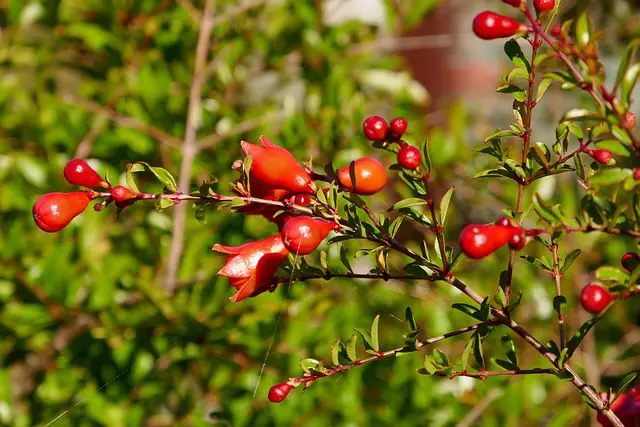
Do pomegranate trees fruit on new or old growth?
Pomegranate trees send out new growth at the ends of established branches and from the base of the plant. Blossoms and fruit appear mostly on the new growth that emerges from older growth (primarily 2- to 3-year-old branches). But, fruiting spurs will continue producing fruit for several years.
So, in a way, pomegranate trees fruit on both new and old wood. Fruiting spurs, whether new or old, tend to be placed toward the ends of branches. This is why it’s important not to over-prune an established pomegranate tree, otherwise you are removing too much potential fruiting wood.
After a few years (perhaps 3-5), fruiting wood becomes woodier and the spurs don’t produce as reliably. You may notice the quality and quantity of fruit starting to diminish. At that time, cut the older fruiting shoot down to the ground and select a new root shoot to grow up and replace it. This practice continually renews the fruiting wood and keeps the pomegranate tree productive.
How do you prune a potted pomegranate tree?
The principles of pruning a potted pomegranate tree are the same as one planted in the ground. The focus is on keeping the tree or shrub compact. The pot itself will naturally help the tree to stay smaller because its roots only have so much room to expand. But, it may take some more aggressive pruning to keep the size in check.
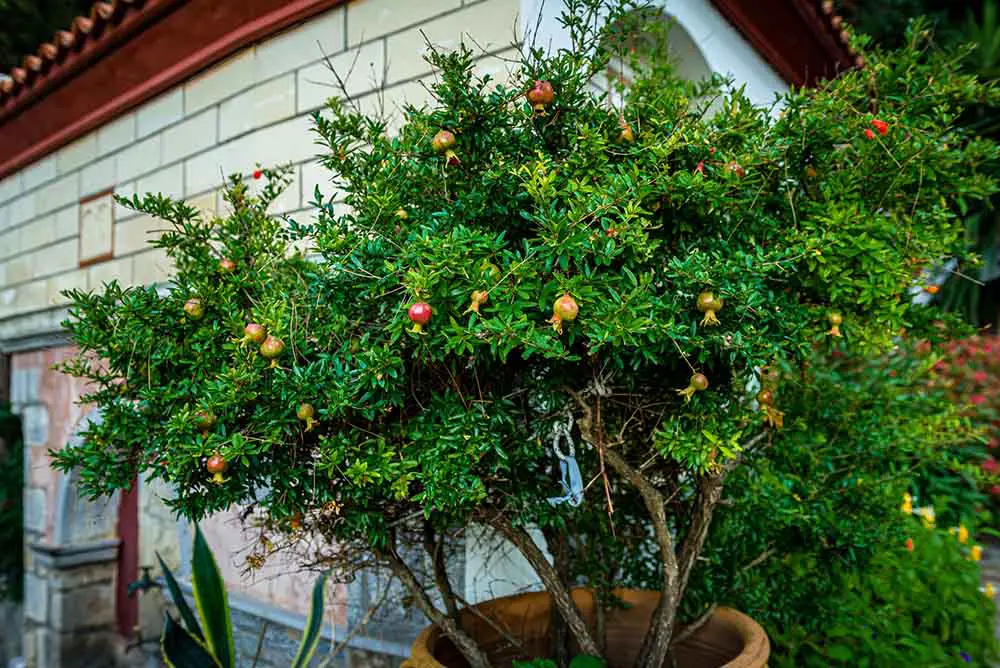
Learn about which varieties are best suited to containers here: Choosing the Perfect Pomegranate Tree (19 Top Varieties)
Establish the main form of the tree the same way as described above. Stay on top of trimming root suckers as soon as they appear so the tree isn’t wasting its limited resources on supporting extra shoots. Keep branches trimmed to a manageable height. As the tree grows larger, move it to a correspondingly larger container.
Pomegranate trees grown indoors year-round may not ever go completely dormant. They will, however, slow their growth significantly after the fruit is harvested. Prune indoor potted pomegranates after the fruit harvest, or in the late winter before the tree starts putting out new growth.
How do you prune a pomegranate tree that’s overgrown?
Prune an overgrown pomegranate tree a little at a time so it doesn’t get too stressed. When the tree is dormant, start by selecting 4-6 main shoots, and remove the rest. Shorten the branches by no more than a third.
The following year, if the tree still needs to be shortened, tip-prune again after the fruit is harvested. Keep removing any unnecessary root suckers, and thin out excessively crowded or crossing branches.

